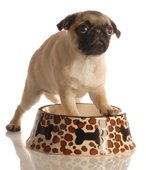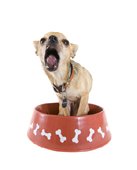 |
 | 
| |
Dog Training DevicesUse the Best Dog Leash and Collar AvailableDog training devices are very effective when you are learning how to train a dog. Use a dog training leash (use the best dog leash for the size, make and temperament of your dog) and a good training collar. There are many dog training devices available. You can use everything from a clicker and food rewards to electronic devices that deliver a small electric shock. There are dog training leash and collars, clickers, toys (to teach come and fetch), harnesses, crates, gates, fences and more. There are pinch collars, training collars, and choke collars; and collars for small dogs and large rambunctious dogs. It is up to you to make the right choice. Clicker and reward training is the easiest and least expensive of all the training devices on the market. The clicker can be as inexpensive as a retractable pen and the rewards can be anything from treats to going for a walk or playtime with you. Use clicker or rewards training on the youngest of puppies, which is when you should really start your training sessions. Dog Training Leash: Choose the Best Dog Leash For Your PetLike all training, leash training, and finding the best dog leash, is essential. For a working dog (a dog thats in service, like an assistance dog), its harness is specially made and created for his job. For regular walking, the best leash is up to you and what you are trying to accomplish. Note: We use a "Sensible" harness and leash for both of our dogs and have found them to be most effective, while not harming or choking the dogs. While many trainers disagree on the best leash, they all agree that the worst leash is the show ring leash. While it looks really good in the show ring, it is only a show piece it is not a good training leash. As with many things in the dog world, form follows function; same thing goes for the leash. A training leash is often shorter, two to three feet, where as a walking leash may be anywhere from four to eight feet long. The shorter leash gives you more control and is double handled which makes it easier on the hands since you dont have to wrap the leash around your hands to shorten the leash for control. One of the handiest leashes out on the market is called the 'pig tail', 'umbilical', or city leash. Its a type of hands-free leash that wraps around the waist and clips onto itself. Its great for joggers or people on the go. Leashes come in all kinds of materials, from nylon to leather. The choice of material does matter: your dog may have allergies to synthetic materials; or you may want a material that is easily washable and long lasting. As your puppy grows, you will find you need to upgrade your leashes and collars. How to Train a Dog? Use Dog Training Devices.It's best to start training when your pup is young and in your own yard before you start walking down the sidewalk. The goal is to keep the leash slack and to keep your dog either beside you or just behind you. The most often used of dog training devices is the leash: training your dog to the leash is like training your dog to anything thing else. It takes time and effort on both your parts. Making a game of it makes it fun for you both and the rewards are many. Not to mention that walking your dog everyday means that not only do you have a fit dog, you will also be more fit! Electronic training devices are used by some dog owners and trainers: they are typically collar or fence devices and work to correct a dog's behavior by emitting a mild electronic shock (it is intended to be a small shock similar to what you might receive if you build up static by walking across a carpet in your socks and then touch something metallic). The intent is to distract, not hurt your dog. We do not use these dog training devices, but many dog owners use them successfully and safely. Take Care of Your Dog's HealthIf you take your dog out frequently and regularly (which is good), it's important to check his or her paws, especially if your dog is under one year old and/or if your pet is not used to long walks and runs. Your dog's paws may get 'sunburned' from hot pavement in the summer months; or get overworked if you're running a lot on paved tracks; and even if you're in grassy or bark mulch areas your pet might get splinters or glass embedded in paws. We recommend a herbal remedy: Pet Alive's PawPaw for healing pets' paw pads - it not only heals sores but it also helps to soothe dry paws. Return to top of Dog Training Devices. Return to The Dog Biscuit Home Page. | Related Articles
Dog Training Tips Basic Dog Obedience Training Equipment Crate Training a Dog Dog Biscuit Recipes Make the Best Rewards Doggy Training Dog Training Advice for Short Term Confinement Dog Training Devices Dog Training Guide for Long Term Confinement Dog Training Hand Signals Free Dog Clicker Training How to Train a Dog to Eliminate Outside? Teach Dog Tricks    | ||
|
Enjoy This Site?
Then why not use the button below, to add us to your favorite bookmarking service? | |||
|
| Home | About
| Contact | Sitemap
| What's New
|Privacy Policy |
This site is for informational purposes only. If you have an issue with your dog's health, please see your vet.
Website design by Webmidwife.com | |||
| | |||







